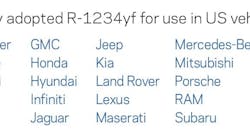Vehicle miles traveled could look similar to the second half of 2020, but many uncertainties still remain.
Michael Chung, director of market intelligence for the Auto Care Association presented industry trends during the Women in Auto Care Week Virtual Conference on Feb. 23.
While overall vehicle miles traveled decreased by 13.1% in 2020 (Figure 1), with the biggest dip in April, things did return to more normal numbers by the second half of the year. Chung said the first half of 2021 could mirror the second half of 2020 as many people continue to work and attend schooling from home, despite working to slowly return to life as “normal.”
The potential impact of remote work is considerable on 2021 vehicle miles driven. In studies from Gartner, Upwork and KPMG, 80 percent of organizations reported they are planning to allow remote work at least part of the time, and nearly half saying they will allow remote work full time, along with flex days and flex hours (Figure 2). Currently, 42 percent of workers — 19.4 million people — are working remotely. While the percentage of workers is expected to decrease to 22 percent working remotely by 2025, this will then account for an estimated 36.2 million workers.
“Light vehicle miles could see a massive decrease,” Chung said.
Retail sales, on the other hand, surged in 2020 despite the pandemic. We saw higher year or year sales in May 2020, despite consumer confidence taking a massive drop (Figure 3).
Consumer showed lower concern with visiting retail stores and automotive repair shops, which helped to drive demand. But there is concern in utilizing ride sharing, with Uber and Lyft sales down 71 percent and 73 percent respectively year over year for December 2020 (Figure 4).
Use of public transportation is also faltering, down 62 percent in the 2020 third quarter compared to the same period in 2019, according to data from the American Public Transportation Association (Figure 5).
“Fewer people are on transit. People are now more comfortable taking vehicles to have their own space to be in,” Chung said.
This is reflected in the used car price spike in the summer 2020, followed by increased sales. New car dealer sales also rebounded in the second half of 2020 as indexed prices rose.
Many trends have emerged that are worth watching — vehicle miles driven, retail sales, vehicle sales and consumer behavior — that will continue to impact the automotive aftermarket and its success going forward (Figure 6).


